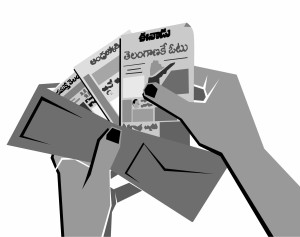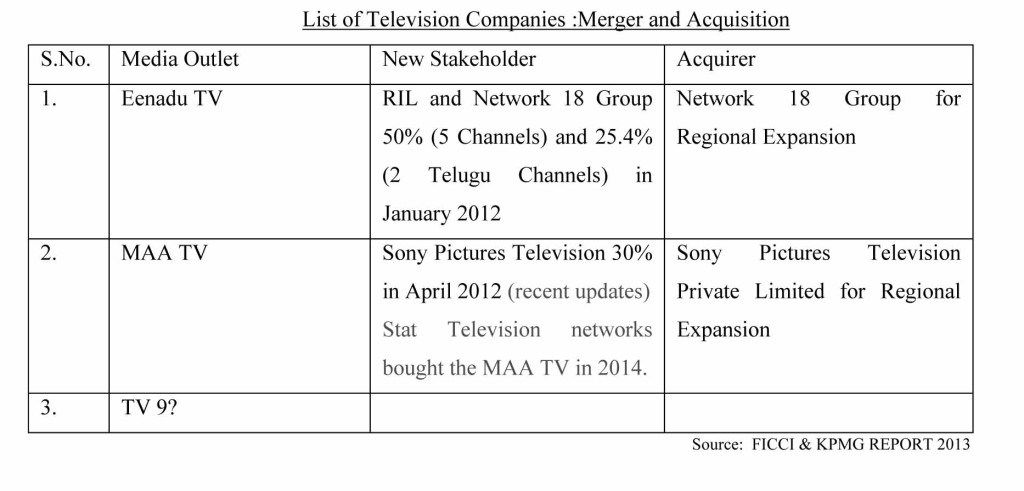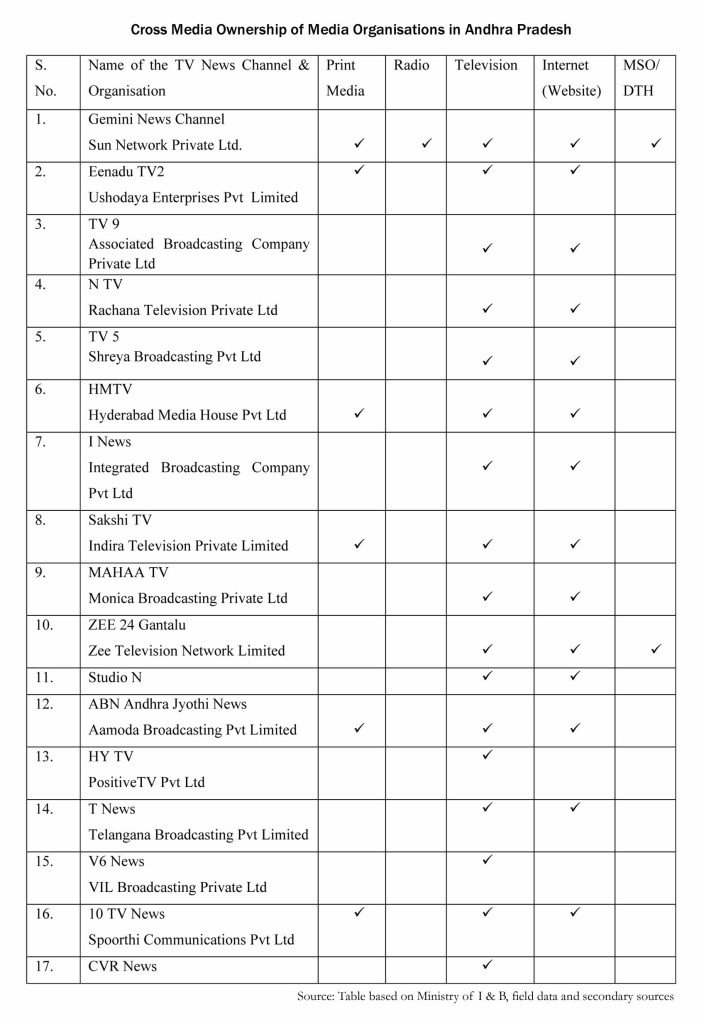– Panthukala Srinivas
The changing face of media ownership has provided several options for political leaders, realtors, businessmen and capitalists. Media organizations in the state of Andhra Praesh and Telangana are often controlled by corporate bodies, real estate agents, political party leaders, businessmen, chit fund companies, liquor barons and seed companies; societies, trusts, sometimes stockholders and rarely journalist-managers. In India there are no cross-media ownership restrictions; anyone can start and own newspapers, television news channels and FM radio stations.
In India’s media landscape, it is said that the number of publications, radio stations, television channels, and internet websites are a guarantor for plurality, diversity, and consumer choice. There were over 82,000 publications registered with the Registrar of Newspapers as on 31 Marc h 2011. There are over 250 FM radio stations in the country though India is the only democracy in the world where news on the radio is still a monopoly of the government. The Ministry of Information & Broadcasting has allowed nearly 800 television channels to uplink or downlink from the country, including over 300 which claim to be television channels broadcasting “news and current affairs”. There are also an unspecified number of websites for social media in India. Thus in this country, which is still home to the largest number of illiterates, poor and malnourished on earth, the proliferation of mass media is impressive.
h 2011. There are over 250 FM radio stations in the country though India is the only democracy in the world where news on the radio is still a monopoly of the government. The Ministry of Information & Broadcasting has allowed nearly 800 television channels to uplink or downlink from the country, including over 300 which claim to be television channels broadcasting “news and current affairs”. There are also an unspecified number of websites for social media in India. Thus in this country, which is still home to the largest number of illiterates, poor and malnourished on earth, the proliferation of mass media is impressive.
Has this expansion and power of media been translated into the greater public good? Is our democracy more mature now? Is there more informed public discourse on account of the media? Are media still a part of the solution as perceived for decades, or have they become a part of the problem? Are there signs of self-correction/ regulation and growing public-spiritedness or is there more decay and crass consumerism at the cost of rational discourse and public good? Such persistent questions have become relevant.
Advertisement revenues in the South Indian states in media industry (FICCI and KPMG; 2012) are: in Tamil Nadu Rs 1,170 crores, in Andhra Pradesh Rs 800 crores and in Karnataka Rs 560 crores. In comparison with the national media (Hindi and English have reached stagnation) the regional languages markets in the South are booming.
Political parties and leaders with political affiliations are increasing their ownership and control of large sections of the television media in Telugu regions. In the case of Ushodaya Enterprises (Eenadu TV Networks) owned by business magnate Ramoji Rao there are on and off alliances with the Telugu Desam Party and significant involvement in its economic interests. Eenadu since it began in 1974 has editorially never been very friendly towards the Congress. Before it supported TDP (formed in 1982) the newspaper was more oriented toward the Kamma dominated communist party. The Emergency declared during the Congress regime was another anti-Congress rallying point for Ramoji Rao. The paper had championed prohibition in the State in opposition to the Congress that had control of the liquor business. The movement did result in a prohibition policy, but there was no critical reaction from the same newspaper when this policy was lifted by the TDP.
The politician Jagan Mohan Reddy, son of the late chief minister, Y. S. Rajasekhara Reddy, owns the newspaper Sakshi and the television channel Sakshi TV, under the umbrella groups of Indira Television Limited and Jagati Publications Ltd. Sakshi TV openly supports YSR Congress party which was started by YS Jagan Mohan Reddy.
The other important media player with a clear political agenda is the current chief minister K. Chandrasekhara Rao and his son K. Taraka Rama Rao who hail from the Velama community. They own and control and the television channel T-News. The Telangana Rashtra Samithi chief KCR and his family control the channel through the holding company, Telangana Broadcasting Private Limited.
TV 5 and N TV management came from the real estate and power businesses. These channels were formed by capitalists with the idea that if they had a television channel in their hands, they could force the government do things that would benefit them. I News channel was established by MRI educational institutions. Studio N channel was backed by Chandrababu Naidu the current Chief Minister of Andhra Pradesh. Recently, the left party, CPI(M), established the TV10 news channel to show their party activities and protests led by them. CPI also started TV99 television news and current affairs channel.
When ETV and MAA TV began, their beginnings were modest starting with one television channel. Soon, they became networks, expanding into other regions. Now their presence in the market has induced them to merge with big companies, turning them into big business corporations, as if following the Rupert Murdoch business model, and having trans-national presence and influencing politics in various regions where they have their business stakes. The case of MAA TV ownership is interesting. Though this is not a news channel, it has stakes in other businesses and political affiliations. The families of the actors Chiranjeevi and Akkineni Nageswara Rao, and Nimmagadda Prasad Rao are stake holders of MAA TV. The film industry and business groups have influenced the growth of the channel and the channel has merged with Sony Pictures Television network. Nimmagadda has shares in Sakshi TV and also other business firms. TV9 has also been in the news for merger with bigger corporations, but so far this has not materialized.
other business firms. TV9 has also been in the news for merger with bigger corporations, but so far this has not materialized.
In India and in the world, large media corporations are today clearly playing a bigger role in the political economy as part of forward and backward linkages plans. In India large international television broadcast networks including Turner/CNN, Viacom/MTV, RIL/ Network 18 and Sony are acquiring or partnering with regional networks. Moreover, a fair degree of consolidation and convergence has already taken place in general across the country and in Telugu regions too. For Example in 2015 Star TV Networks has acquired all MAA TV broadcasting channels.
Ankam Ravi Chief News Editor and CEO of V6 News says:
“The affordability/low cost will help in widening the media reach. Now one can set up a channel with just 10 crores to 150 crores. Content is primary thing, more important than the technology; the content should be diverse and attractive. But there are always hurdles in reaching the public, and now the distribution system is under the control of a few media houses. We should see the media organisations as business enterprises and so we cannot expect social responsibility from them. In 2014 General Elections, the media’s impact on public was 100 percent whereas it was 30 percent in 2009 elections. Now, I think there will be no such influence on the public in the next election to be held in 2019 as the number of channels have increased in AP. There is no chance of deceiving the public. This is good for democracy”. (Personal Interview, 2013).
Diverse views are expressed by Vijay Narra about television journalism in AP, “there is a difference between past and present journalists. Presently, journalists are owned and controlled by media barons and everything goes according to the owners’ will in covering the news or its presentation. Journalists freedom is snatched from their control and they do not have right to cover the news at will. Moreover, they have to work as per the policies and principles of the owners” (Personal interview, 2013).
Padmaja Shaw who teaches communication and journalism at Osmania University said the following regarding cross media ownership:”If there is an information monopoly situation, there is something to worry about. Today Eenadu is a very high ranking newspaper maintaining first position, whereas E TV it is not doing so well. TV9 and TV5 does not have a newspaper but they are doing well in TV Industry and Market. The problem comes when two or three channels get together in support of one political party. That is called information cartelization”. (Personal interview, 2013).
Explaining cross-media ownership and its impact on the society Madhusudan Pamidikalva says, “Cross-media ownership is always a threat and danger to society in the long run. In the present day scenario, establishing a television channel requires a minimum of 20 crores rupee investment. To start a print media house, 400-600 crores are needed. This can’t be done by an individual journalist or even b y a group of them where as an MNC or a business syndicate can. When they gain control over three segments of the media i.e TV, radio and news paper, the people have less options to choose from.
y a group of them where as an MNC or a business syndicate can. When they gain control over three segments of the media i.e TV, radio and news paper, the people have less options to choose from.
“On the other hand a few channels like Vissa TV, Zee 24 Gantalu, HYTV, RVS, RK News are using satellite and have incurred financial losses. Asianet, Sitara TV, Satya TV and Tulasi TV have not yet done so. These channels are well supported and can run for 1-2 years in case of the loss but when such channels when a situation arises, they usually tie-up with one of the political parties. Raj TV, N TV, Studio N etc, are channels that may not sustain themselves if become fully commercial. In all our television networks, Zee network is the most profitable one—but as a news channel it is a failure. It is now running on contract basis for a political party. No one can guess the future of the Zee News once the agreement is over. So overall, starting a television channel has become viable and affordable (Personal interview, 2013).
The corporatization of media and cross-media ownership is a dangerous trend in India. It is a weapon in the hands of corporations for vertical and horizontal spread across the fields in India. Cross-media conglomeration reduces competition and denies entry to newcomers and small entrepreneurs. A report1 recommending restriction on cross-media ownership says there is an “ample evidence of market dominance” in specific media markets and argues in favour of an “appropriate” regulatory framework to enforce cross-media ownership restrictions, especially in regional media markets where there is “significant concentration” and market dominance in comparison to national markets (for the Hindi and English media).
The Standing Committee on IT, headed by Congress MP Rao Inderjit Singh, stressed the critical need for restrictions on cross-media ownership. It urged the Ministry to “formulate” its stand on the issue in coordination with TRAI “after taking into account” international practices. There has been strong resistance on the part of media groups to the idea of restrictions on their sector, arguing that regulation would stifle growth, and that the multiplicity of media and the highly fragmented nature of the Indian market prevents monopolization and further that regulation of the sector amounts to an impingement on the Constitutional right to freedom of speech.
However, with this trend, alternative perspectives and media outlets vanish from the mainstream. Media coalesce into a seamless, pervasive, and increasingly homogenized cultural environment that has drifted out of democratic reach. The data suggests that there is a need of broadcast regulation or self-regulation for television in India.
Panthukala Srinivas teaches at English and Foreign Languages University
seenanna@gmail.com![]()

